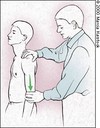PD Musculoskeletal Upper and Lower Extremity Exam Flashcards
oh lawd help me
Each extremity/joint needs to be inspected for these 7 things..
- Symmetry
- Atrophy/hypertrophy
- Swelling
- Erythema
- Deformity
- Bony landmarks
- Skin
Palpating a joint allows for assessment of…
Warmth, tenderness, deformity, crepitus
Range of motion tests should be ____ first then ____
Active, passive
Palpations on the shoulder
Sternoclavicular joint to acromioclavicular joint
Range of motion on shoulder
Flexion, extension, abduction, adduction, internal rotation, external rotation, Apley’s scratch test!!

Deltoid muscle strength test

Supraspinatus/empty can test

Lift off/subscapularis test

Serratus anterior test

Rhomboid test, verebral border of scapula should not wing out

Neer’s impingement sign, pain suggestive of subacromial impingement

Hawkins Kennedy test for impingement

Adson’s test for subclavian artery compression, thoracic outlet syndrome (don’t forget to palpate the pulse yo)

AC joint arthrosis test

Apprehension test for anterior shoulder instability

Sulcus sign for inferior shoudler instability

Jerk sign for posterior shoulder instability

Load and shift test for anterior and posterior shoulder instability
Range of motion on elbow
Flexion, extension, pronation, supination

Lateral epiconditis (tennis elbow), pain with resisted extension of wrist

Medial epicnodylitis (golfer’s elbow) test - palpate, resisted pronate, flex wrist
Range of motion on wrist
Flexion, extension, ulnar deviation, radial deviation


















